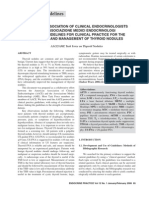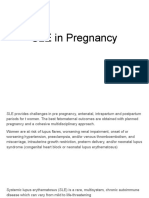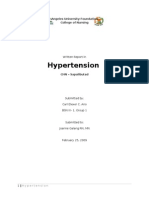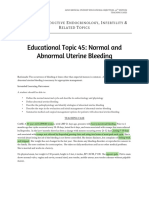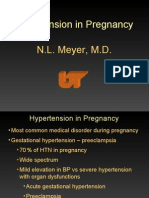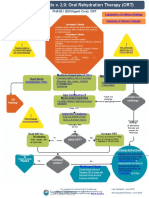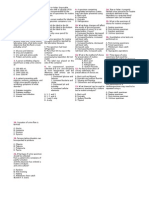TC18
TC18
Uploaded by
Robert BarnesCopyright:
Available Formats
TC18
TC18
Uploaded by
Robert BarnesCopyright
Available Formats
Share this document
Did you find this document useful?
Is this content inappropriate?
Copyright:
Available Formats
TC18
TC18
Uploaded by
Robert BarnesCopyright:
Available Formats
TH
APGO MEDICAL STUDENT EDUCATIONAL OBJECTIVES, 10 EDITION
TEACHING CASES
U N I T 2: O B S T E T R I C S
SECTION B: ABNORMAL OBSTETRICS
Educational Topic 18:
Preeclampsia-Eclampsia
Rationale: Preeclampsia-eclampsia accounts for significant morbidity and mortality in both the mother and newborn.
Intended Learning Outcomes:
A student should be able to:
Define the types of hypertension in pregnancy
Describe the pathophysiology of preeclampsia-eclampsia
List risk factors for preeclampsia
Recognize the signs and symptoms to diagnose preeclampsia-eclampsia
Explain the management of a patient with preeclampsia-eclampsia
List the maternal and fetal complications associated with preeclampsia-eclampsia
TEACHING CASE
CASE: An 18 year old G1P0 currently at 38 0/7 weeks presents for her routine prenatal visit. She has had an uncompli2
cated pregnancy up to this point, with the exception of a late onset of prenatal care and obesity (BMI of 35 kg/m ). She
reports that during the past week, she has noted some swelling of her hands and feet. She also has been feeling a bit
more fatigued and has had a headache on and off. She reports good fetal movement. She has had some contractions on
and off, but nothing persistent. Her blood pressure is 147/92 and her urine dip has 1+ protein/no ketones/no glucose.
The fundal height measures 36 cm, the fetus is cephalic with a heart rate of 144 bpm. On physical exam you note that
the patient has 3+ pre-tibial edema, and trace edema of her hands and face. She has 2+ deep tendon reflexes and 2 beats
of clonus. You review her blood pressures up to this point and note that at the time of her first prenatal visit at 18
weeks, her blood pressure was 130/76 and she had no protein in her urine. However, since that visit, her blood pressures seem to have been climbing higher with each visit. Her last visit was one week ago, and she had a blood pressure
of 138/88 with trace protein in the urine and she has gained 5 pounds.
TH
APGO MEDICAL STUDENT EDUCATIONAL OBJECTIVES, 10 EDITION
TEACHING CASES
COMPETENCY-BASED DISCUSSION & KEY TEACHING POINTS:
Competencies addressed:
Patient care
1.
Medical Knowledge
System-Based Practice
What is considered a hypertensive blood pressure during pregnancy?
2.
What types of hypertensive syndromes can occur during pregnancy?
3.
Chronic hypertension: Requires that the patient have documented hypertension preceding 20 weeks
gestation, or where hypertension is first noted during pregnancy and persists for longer than 12 weeks
postpartum
Preeclampsia-eclampsia: Development of new onset hypertension and proteinuria after 20 weeks of
pregnancy. Is stratified into mild and severe forms. There are atypical forms of preeclampsia as well.
Preeclampsia superimposed on chronic hypertension: Superimposed preeclampsia should be reserved for those
women with chronic hypertension who develop new-onset proteinuria ( 300 mg in a 24-hour collection)
th
after the 20 week of pregnancy. In pregnant women with preexisting hypertension and proteinuria, the
diagnosis of superimposed preeclampsia should be considered if the patient experiences sudden significant
increases in blood pressure or proteinuria or any of the other signs and symptoms consistent with severe
preeclampsia.
Gestational Hypertension: Hypertension without proteinuria which first appears after 20 weeks gestation or
within 48 to 72 hours after delivery and resolves by 12 weeks postpartum.
How does the physiology of preeclampsia lead to the clinical symptoms and findings?
4.
In pregnancy, hypertension is defined as either a systolic blood pressure 140 or diastolic blood pressure
90 or both.
Hypoxia, hypoperfusion and ischemia lead to the clinical placental pathophysiology (with fetal
compromise: IUGR, oligohydramios, placental abruption)
Systemic endothelial dysfunction leads to central & peripheral edema, proteinuria, and hypertension
(from disruption of vascular regulation). Endothelial dysfunction in target organs leads to headache,
epigastric pain, and renal dysfunction. Microvascular endothelial destruction leads to release of
procoagulants and DIC.
What are the laboratory findings that support a diagnosis of preeclampsia-eclampsia syndrome?
Proteinuria (> 300 mg on a 24 hour urine collection)
Elevated hematocrit
Hemolysis
3
Thrombocytopenia (< 100,000 cells/mm )
Elevated liver enzymes (ALT/AST twice normal)
Elevated serum uric acid concentration
Copyright 2014 by Association of Professors of Gynecology and Obstetrics (APGO).
For permissions: apgoadmin@apgo.org
TH
APGO MEDICAL STUDENT EDUCATIONAL OBJECTIVES, 10 EDITION
TEACHING CASES
5.
What types of maternal and fetal complications are associated with preclampsia-eclampsia syndrome?
Maternal:
CNS: eclamptic seizure, stroke
Cardiopulmonary: pulmonary edema
Hepatic: Subcapsular hematoma or hepatic rupture
Renal: renal failure or acute tubular necrosis
Hematologic: hemorrhage, DIC
Fetal:
Preterm delivery
Abruptio Placenta
Fetal growth restriction
Hypoxic ischemic encephalopathy
Fetal death
REFERENCES
Beckman CRB, et al. Obstetrics and Gynecology. 7th ed. Philadelphia: Lippincott, Williams & Wilkins, 2013.
Hacker NF, Moore JG, et al. Essentials of Obstetrics and Gynecology. 5th ed. Philadelphia: Saunders, 2010.
Sibai B. Diagnosis and Management of Gestational Hypertension and Preeclampsia. ObstetGynecol. High-Risk Pregnancy Series: An Expert's View. Jul 2003; (102) 1 - p 181-192.
Lain KY, Roberts JM. Contemporary concepts of the pathogenesis and management of preeclampsia. JAMA. Jun
26 2002; 287(24):3183-6.
Copyright 2014 by Association of Professors of Gynecology and Obstetrics (APGO).
For permissions: apgoadmin@apgo.org
You might also like
- Essential Neurology 4Th Ed PDFDocument290 pagesEssential Neurology 4Th Ed PDFPutu 'yayuk' Widyani WiradiraniNo ratings yet
- Derain Carla Elize-Group9 DXRDocument6 pagesDerain Carla Elize-Group9 DXRCarla Elize Derain100% (1)
- Approach To The Patient With An Adnexal Mass - UpToDateDocument31 pagesApproach To The Patient With An Adnexal Mass - UpToDateRamackNo ratings yet
- Case 16 Pediatric t1dmDocument12 pagesCase 16 Pediatric t1dmapi-501730091No ratings yet
- The Management of DVT: Dr. Heru Sulastomo, SP - JP (K), FIHA Dr. Ahmad Yasa', SP - JP, FIHA, MkesDocument19 pagesThe Management of DVT: Dr. Heru Sulastomo, SP - JP (K), FIHA Dr. Ahmad Yasa', SP - JP, FIHA, MkesDEWI MULYANINo ratings yet
- Polycystic Ovarian SyndromeDocument36 pagesPolycystic Ovarian SyndromeRaras Mayang100% (1)
- NCP Ineffective Tissue Perfusion (Eclampsia)Document1 pageNCP Ineffective Tissue Perfusion (Eclampsia)Jenny AjocNo ratings yet
- Case StudyDocument21 pagesCase StudyLuige AvilaNo ratings yet
- Hydatidiform MoleDocument23 pagesHydatidiform MoleKristel Rivamonte100% (1)
- SecondaryDiabetes Chapter25Document34 pagesSecondaryDiabetes Chapter25Pamela Musabelliu100% (1)
- Clinical CaseDocument17 pagesClinical CaseDev ROYNo ratings yet
- Endocrine HTNDocument32 pagesEndocrine HTNatik mayasariNo ratings yet
- Thyroid NodulesDocument34 pagesThyroid NodulesEphobiaNo ratings yet
- Essential Messages - 2023 DiabetesDocument13 pagesEssential Messages - 2023 Diabetesimran karimNo ratings yet
- Effects of Hypokalaemia On The ECGDocument1 pageEffects of Hypokalaemia On The ECGSahan EpitawalaNo ratings yet
- Sle in PregnancyDocument19 pagesSle in PregnancyShravyaNo ratings yet
- Secondary Arterial HypertensionDocument32 pagesSecondary Arterial HypertensionAndi SusiloNo ratings yet
- Hypertension Study GuideDocument4 pagesHypertension Study GuideCarl Elexer Cuyugan AnoNo ratings yet
- Renal Reabsorption and SecretionDocument5 pagesRenal Reabsorption and SecretionTawhid ZihadNo ratings yet
- Dating Scan Basic and Advanced US 07032020 HTAADocument69 pagesDating Scan Basic and Advanced US 07032020 HTAAMohd Daud Che YusofNo ratings yet
- Endocrinology, Diabetes, and Metabolism - American Board of Internal Medicine - ABIMDocument3 pagesEndocrinology, Diabetes, and Metabolism - American Board of Internal Medicine - ABIMabimorgNo ratings yet
- Drugs Affecting Blood PressureDocument54 pagesDrugs Affecting Blood PressureJeremy VivitNo ratings yet
- Combined Orals APGODocument52 pagesCombined Orals APGOEmilee Tu0% (1)
- Metabolic Syndrome Is Related Cardio-Cerebro Vascular DiseaseDocument40 pagesMetabolic Syndrome Is Related Cardio-Cerebro Vascular DiseaseSatya FitriansyahNo ratings yet
- Drugs For The Treatment of Diabetes MellitusDocument51 pagesDrugs For The Treatment of Diabetes MellitusRaga ManduaruNo ratings yet
- Abnormal Liver Function Test LGHDocument35 pagesAbnormal Liver Function Test LGHElaineNo ratings yet
- Hyperprolactinemia: OverviewDocument14 pagesHyperprolactinemia: OverviewAminaNo ratings yet
- Tall StatureDocument24 pagesTall StaturedianmutiaNo ratings yet
- Approach To Cough: Mark Angelo Z. Ponferrado, MD Pre-ResidentDocument32 pagesApproach To Cough: Mark Angelo Z. Ponferrado, MD Pre-ResidentMark Angelo PonferradoNo ratings yet
- Morning Report: August 28, 2013 Jessica Miller, MD, PGY2Document30 pagesMorning Report: August 28, 2013 Jessica Miller, MD, PGY2Emily EresumaNo ratings yet
- Albumin: Pathophysiologic Basis of Its Role in The Treatment of Cirrhosis and Its ComplicationsDocument26 pagesAlbumin: Pathophysiologic Basis of Its Role in The Treatment of Cirrhosis and Its Complicationsravi raj100% (1)
- Subcutaneous EmphysemaDocument95 pagesSubcutaneous EmphysemaRaina AbadNo ratings yet
- Gi ProformaDocument6 pagesGi ProformaPraveen RavishankaranNo ratings yet
- Biochemical Changes in PregnancyDocument6 pagesBiochemical Changes in PregnancyDr.Aaisha Mohammed Al BalushiNo ratings yet
- Pre and Post PregnancyDocument23 pagesPre and Post PregnancyJitendra ChaudharyNo ratings yet
- Henoch Schönlein PurpuraDocument12 pagesHenoch Schönlein PurpuraRavania Rahadian Putri100% (1)
- Actions of Thyroid Hormone: Dr. Ayisha Qureshi Assistant Professor MBBS, MphilDocument41 pagesActions of Thyroid Hormone: Dr. Ayisha Qureshi Assistant Professor MBBS, MphilJyoti ChadhaNo ratings yet
- HypertensionDocument6 pagesHypertensionTj Kevin P-DoctorNo ratings yet
- Hypertension in Pregnancy: N.L. Meyer, M.DDocument52 pagesHypertension in Pregnancy: N.L. Meyer, M.DnushadNo ratings yet
- HyperkalemiaDocument19 pagesHyperkalemiaporboNo ratings yet
- Acute Gastroenteritis (AGE)Document37 pagesAcute Gastroenteritis (AGE)Sari HariyaniNo ratings yet
- Transport of Oxygen and Carbon DioxideDocument22 pagesTransport of Oxygen and Carbon DioxideAiza Ayaz100% (1)
- Approach To Patient With Renal DiseaseDocument74 pagesApproach To Patient With Renal DiseaseSaja SaqerNo ratings yet
- Seminar 2 (Paeds)Document31 pagesSeminar 2 (Paeds)Jonathan YeohNo ratings yet
- Insulin and Oral Hypoglycemic DrugsDocument30 pagesInsulin and Oral Hypoglycemic DrugsAngga NugrahaNo ratings yet
- Suggested Guidelines For Discussion (AutoRecovered)Document12 pagesSuggested Guidelines For Discussion (AutoRecovered)Muntaser AnaswahNo ratings yet
- Approach To Diabetes Mellitus in YoungDocument41 pagesApproach To Diabetes Mellitus in YoungLalrin ChhanaNo ratings yet
- Hepatitis in Children: DR Hamza BawumiaDocument36 pagesHepatitis in Children: DR Hamza BawumiaHamza Bawumia100% (1)
- Myocardial Infarction QuestionsDocument10 pagesMyocardial Infarction Questionsdsaitta108No ratings yet
- Hypertension in Pregnancy-LatestDocument32 pagesHypertension in Pregnancy-LatestshahiraazNo ratings yet
- NafldDocument30 pagesNafldprabhatguyNo ratings yet
- Bio StatisticsDocument101 pagesBio StatisticshferdjalNo ratings yet
- Achalasia: Department of MedicineDocument21 pagesAchalasia: Department of Medicinekyliever100% (1)
- Abdominal PainDocument44 pagesAbdominal PainAjo YayanNo ratings yet
- ECG Changes Due To Electrolyte Imbalance (Disorder) - ECG LearningDocument1 pageECG Changes Due To Electrolyte Imbalance (Disorder) - ECG LearningRadhika MNo ratings yet
- Pex 10 01Document5 pagesPex 10 01marinaNo ratings yet
- ERCPDocument11 pagesERCPMalaak BassamNo ratings yet
- Caso Clínico de DislipidemiaDocument3 pagesCaso Clínico de DislipidemiaCamiiliita Fernández La TorreNo ratings yet
- Obstetrics Case PresentationDocument27 pagesObstetrics Case PresentationMahaprasad sahoo 77No ratings yet
- PheochromocytomaDocument74 pagesPheochromocytomamichaelNo ratings yet
- Clinical Case Presentation Anemia in Pregnancy: Ahmed Farrasyah Bin Mohd Kutubudin 071303511 Batch 24 Group A2Document32 pagesClinical Case Presentation Anemia in Pregnancy: Ahmed Farrasyah Bin Mohd Kutubudin 071303511 Batch 24 Group A2kalpana gondipalliNo ratings yet
- Ketorolac AHFSDocument17 pagesKetorolac AHFSRIRINo ratings yet
- Thalassemia: DR Husain AlmukharraqDocument9 pagesThalassemia: DR Husain AlmukharraqUm HamoOdNo ratings yet
- Nursing Care With EclampsiaDocument40 pagesNursing Care With EclampsiaNadia DesyerianNo ratings yet
- Nasopharyngeal PathophysiologyDocument3 pagesNasopharyngeal PathophysiologyMichael Anthony ReginaldoNo ratings yet
- Golden Rules in OncologyDocument76 pagesGolden Rules in OncologyDragonNo ratings yet
- Impetigo KrustosaDocument23 pagesImpetigo KrustosakacaacdhgjhlkNo ratings yet
- Cardiac Condition NCM 112Document10 pagesCardiac Condition NCM 112Irish Eunice FelixNo ratings yet
- 2019 ENT Nursing Exam 1Document7 pages2019 ENT Nursing Exam 1KAUH EducationNo ratings yet
- CM Chapter 3 1. 5. 9. 14.: True or False: Disposable True or False: A ProperlyDocument2 pagesCM Chapter 3 1. 5. 9. 14.: True or False: Disposable True or False: A ProperlyDingdongLopezNo ratings yet
- TARGET SURGERY EOP 2 SAQsDocument10 pagesTARGET SURGERY EOP 2 SAQsLawrence BabawoNo ratings yet
- Ovarian CancerDocument34 pagesOvarian CancerHealth Education Library for People100% (4)
- School of Health and Naturalsciences Nursing Department Bayombong, Nueva VizcayaDocument3 pagesSchool of Health and Naturalsciences Nursing Department Bayombong, Nueva VizcayaAj NavNo ratings yet
- Little and Falaces Dental Management of The Medically Compromised Patient 8th Edition Little Test BankDocument7 pagesLittle and Falaces Dental Management of The Medically Compromised Patient 8th Edition Little Test Bankmairowan63u100% (43)
- Paediatric DermatologyDocument31 pagesPaediatric DermatologySana Bushra100% (1)
- Anoscopy: Top 10 Forgotten Diagnostic ProceduresDocument1 pageAnoscopy: Top 10 Forgotten Diagnostic ProceduresI G. A. Ratna DewiNo ratings yet
- Syphilis Fact Sheet PressDocument2 pagesSyphilis Fact Sheet Pressmahaberani_zNo ratings yet
- Module 8-NSTP 1-Health Program, Common Illness & Their PreventionDocument46 pagesModule 8-NSTP 1-Health Program, Common Illness & Their PreventionLalaine AlonNo ratings yet
- Kajian Penggunaan Obat Kemoterapi Pada Pasien Leukemia Anak Di Rsud Abdul Wahab Sjahranie Kota SamarindaDocument8 pagesKajian Penggunaan Obat Kemoterapi Pada Pasien Leukemia Anak Di Rsud Abdul Wahab Sjahranie Kota SamarindaamandaNo ratings yet
- Anthropometric MeasurementsDocument3 pagesAnthropometric Measurementssabao kizuiteNo ratings yet
- HGDocument7 pagesHGRuchi HumaneNo ratings yet
- Activity 12 MicrolabDocument3 pagesActivity 12 MicrolabDarius June Nolasco SacupasoNo ratings yet
- Narrative ReportDocument1 pageNarrative ReportMichaelNo ratings yet
- Corpuz, Lorelyn S - NCP (Colostomy and Ileostomy)Document3 pagesCorpuz, Lorelyn S - NCP (Colostomy and Ileostomy)Lorelyn Santos CorpuzNo ratings yet
- Clinical Characteristics and Prognostic Factors of Children With Anti-N-Methyl-D-Aspartate Receptor EncephalitisDocument9 pagesClinical Characteristics and Prognostic Factors of Children With Anti-N-Methyl-D-Aspartate Receptor EncephalitisSara IsabelNo ratings yet
- UM 1 Mock 2 16.8.18Document18 pagesUM 1 Mock 2 16.8.18Anonymous d1CGjMTiNo ratings yet
- Mango LeavesDocument5 pagesMango LeavesMuthuswamy JayaramNo ratings yet
- Hypertensive Cardiovascular DiseaseDocument2 pagesHypertensive Cardiovascular DiseaseYna AcerdenNo ratings yet
- Coronavirus Reading ComprehensionDocument4 pagesCoronavirus Reading ComprehensionMiky MikyNo ratings yet
- SA MP LE: Brief Pain Inventory (Short Form)Document2 pagesSA MP LE: Brief Pain Inventory (Short Form)Marcela Leal GarcíaNo ratings yet












